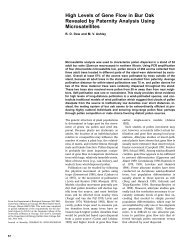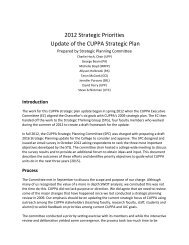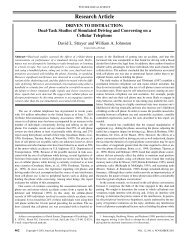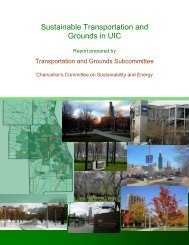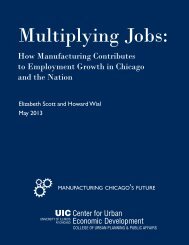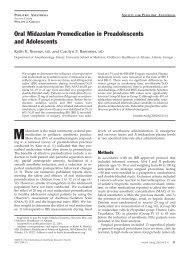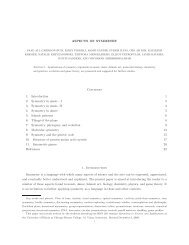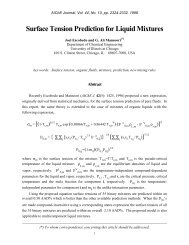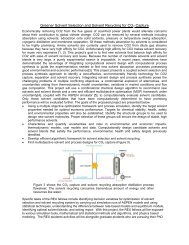The concentrations of electrolytes in charged cylindrical pores: The ...
The concentrations of electrolytes in charged cylindrical pores: The ...
The concentrations of electrolytes in charged cylindrical pores: The ...
Create successful ePaper yourself
Turn your PDF publications into a flip-book with our unique Google optimized e-Paper software.
<strong>The</strong> <strong>concentrations</strong> <strong>of</strong> <strong>electrolytes</strong> <strong>in</strong> <strong>charged</strong> cyl<strong>in</strong>drical <strong>pores</strong>:<br />
<strong>The</strong> hydrostatic hypernetted cha<strong>in</strong>/mean spherical approximation<br />
Parisa Za<strong>in</strong>i and Hamid Modarress<br />
Department <strong>of</strong> Chemical Eng<strong>in</strong>eer<strong>in</strong>g, Amirkabir University <strong>of</strong> Technology, 424 Hafez Avenue, Tehran, Iran<br />
G. Ali Mansoori a)<br />
Department <strong>of</strong> Chemical Eng<strong>in</strong>eer<strong>in</strong>g, University <strong>of</strong> Ill<strong>in</strong>ois, 810 S. Cl<strong>in</strong>ton Street,<br />
Chicago, Ill<strong>in</strong>ois 60607-7000<br />
Received 21 August 1995; accepted 1 December 1995<br />
<strong>The</strong> zeroth order hydrostatic approximation for <strong>in</strong>homogeneous system is applied <strong>in</strong> the<br />
hypernetted cha<strong>in</strong>/mean spherical HNC/MSA equations for <strong>charged</strong> cyl<strong>in</strong>drical <strong>pores</strong>. <strong>The</strong> derived<br />
equations are <strong>in</strong>troduced as hydrostatic hypernetted cha<strong>in</strong>/mean spherical approximation HHNC/<br />
MSA. <strong>The</strong>se equations are solved us<strong>in</strong>g the collocation version <strong>of</strong> the f<strong>in</strong>ite element method.<br />
Equilibrium density pr<strong>of</strong>iles and mean electrostatic potential pr<strong>of</strong>iles are presented and compared<br />
with the results <strong>of</strong> HNC/MSA equations. Density pr<strong>of</strong>iles and Exclusion coefficient pr<strong>of</strong>iles for 1:1<br />
and 1:2 <strong>electrolytes</strong> are also compared with the grand canonical Monte Carlo GCMC data. Good<br />
agreement between the present calculations and GCMC data are observed. Quantitative differences<br />
between the present calculations and HNC/MSA are found which are especially significant for large<br />
pore diameters and high electrolyte <strong>concentrations</strong>. © 1996 American Institute <strong>of</strong> Physics.<br />
S0021-96069650510-0<br />
INTRODUCTION<br />
A material conta<strong>in</strong><strong>in</strong>g <strong>charged</strong> micro<strong>pores</strong>, surrounded<br />
by bulk electrolyte, may conta<strong>in</strong> a different concentration <strong>of</strong><br />
electrolyte than the surround<strong>in</strong>g solution. <strong>The</strong> study <strong>of</strong> this<br />
apparently simple phenomenon, the distribution <strong>of</strong> electrolyte<br />
between the porous phase and the bulk solution, is fundamental<br />
to many chemical, biological and eng<strong>in</strong>eer<strong>in</strong>g processes,<br />
and recently has become the subject <strong>of</strong> considerable<br />
theoretical and experimental activities. 1<br />
Materials conta<strong>in</strong><strong>in</strong>g <strong>charged</strong> micro<strong>pores</strong>, such as ionexchange<br />
res<strong>in</strong>s, cellophane membranes, glass, and certa<strong>in</strong><br />
clays, have long been known to have the property <strong>of</strong> partially<br />
‘‘reject<strong>in</strong>g’’ an electrolyte which is filtered through them. 2–6<br />
Most frequently the electrolyte is dilute and aqueous, and the<br />
concentration <strong>of</strong> the <strong>in</strong>vad<strong>in</strong>g electrolyte turns out to be<br />
lower <strong>in</strong> the porous phase than <strong>in</strong> the surround<strong>in</strong>g aqueous<br />
phase, hence the term ‘‘rejection’’ <strong>of</strong> electrolyte has been<br />
used to expla<strong>in</strong> this phenomenon.<br />
<strong>The</strong> ability <strong>of</strong> porous materials to exclude an electrolyte<br />
forms the basis <strong>of</strong> important technological processes such as<br />
the desal<strong>in</strong>ation <strong>of</strong> water. <strong>The</strong>re are also other phenomena <strong>in</strong><br />
which the equilibrium distribution <strong>of</strong> ions plays an essential<br />
role, such as electrochemical energy conversion studies, 7,8<br />
and the theory <strong>of</strong> ion-exchange res<strong>in</strong>s. 9<br />
<strong>The</strong> equilibrium structure <strong>of</strong> <strong>electrolytes</strong> conf<strong>in</strong>ed to the<br />
<strong>pores</strong>, will determ<strong>in</strong>e the net pressure on the <strong>charged</strong> surfaces<br />
and will <strong>in</strong>fluence the flow <strong>of</strong> electrolyte through the<br />
pore.<br />
<strong>The</strong> classical approach to the study <strong>of</strong> the ionic concentration<br />
is to solve the Poisson–Boltzman PB equation. <strong>The</strong><br />
PB theory fails <strong>in</strong> some cases and has been substituted by<br />
a Author to whom correspondence should be addressed.<br />
other <strong>in</strong>tegral equation theories. For the cyl<strong>in</strong>drical geometry<br />
this has an analytical solution only <strong>in</strong> its l<strong>in</strong>earized form. 10<br />
<strong>The</strong> PB theory under especial conditions, which <strong>in</strong>clude high<br />
surface charge density, high electrolyte concentration, or<br />
ionic valences greater than one, has large error. This is due to<br />
the fact that this approach ignores the size <strong>of</strong> the ions. In the<br />
recent 20 years, many developments have been made for<br />
statistical mechanical theories <strong>of</strong> fluids. 11–14 <strong>The</strong> hypernetted<br />
cha<strong>in</strong>/mean spherical approximation HNC/MSA which is<br />
also based on statistical mechanics, has been applied for<br />
planar, 12 spherical, 13 and cyl<strong>in</strong>drical 14 systems and also for<br />
<strong>electrolytes</strong> conf<strong>in</strong>ed between two planar electrical double<br />
layer’s EDL. 15<br />
Computer simulation <strong>of</strong> electrical double layer <strong>in</strong>side<br />
<strong>charged</strong> cyl<strong>in</strong>ders have been made by Jannik and Vlachy for<br />
symmetrical and unsymmetrical salts. 16 This simulation<br />
which has been made us<strong>in</strong>g Monte Carlo MC method <strong>in</strong> a<br />
grand canonical ensemble, has been used as a substitution for<br />
the experimental measurements.<br />
An earlier HNC/MSA study <strong>of</strong> the cyl<strong>in</strong>drical pore was<br />
carried out by Vlachy and McQuarrie us<strong>in</strong>g the planar<br />
double-layer version <strong>of</strong> MSA. 17 Other <strong>in</strong>tegral equation approaches<br />
to cyl<strong>in</strong>drical <strong>pores</strong> <strong>in</strong>clude the work <strong>of</strong> Zhou and<br />
Stell on un<strong>charged</strong> hard-sphere fluids. 18 A more complete<br />
form <strong>of</strong> this equation for cyl<strong>in</strong>drical EDL consider<strong>in</strong>g angular<br />
dependence <strong>of</strong> the ion–ion <strong>in</strong>teractions, was derived by<br />
Yeomans et al. 19 All these equations are based on direct application<br />
<strong>of</strong> the homogeneous Ornste<strong>in</strong>–Zernike OZ equation<br />
to <strong>in</strong>homogeneous fluids, called the direct method<br />
DM. 20 Although these equations are successful there is still<br />
a need for more accurate equation based on a comprehensive<br />
model. Many modified equations have been proposed for homogeneous<br />
systems but not for <strong>in</strong>homogeneous systems.<br />
Zhou and Stell, 21 have used the two-body Ornste<strong>in</strong>–Zernike<br />
3832 J. Chem. Phys. 104 (10), 8 March 1996 0021-9606/96/104(10)/3832/9/$10.00 © 1996 American Institute <strong>of</strong> Physics<br />
Downloaded¬25¬Oct¬2001¬to¬131.193.142.216.¬Redistribution¬subject¬to¬AIP¬license¬or¬copyright,¬see¬http://ojps.aip.org/jcpo/jcpcr.jsp
Za<strong>in</strong>i, Modarress, and Mansoori: Electrolytes <strong>in</strong> <strong>charged</strong> <strong>pores</strong><br />
3833<br />
solvent is considered to be a cont<strong>in</strong>uous medium <strong>of</strong> dielectric<br />
constant . <strong>The</strong> pore is an <strong>in</strong>f<strong>in</strong>itely long hard cyl<strong>in</strong>der<br />
such that edge effects can be ignored <strong>of</strong> radius (t) with a<br />
uniformly distributed charge density on the <strong>in</strong>ner surface.<br />
<strong>The</strong> pore is composed <strong>of</strong> a material with the same dielectric<br />
constant as the solvent, such that image forces need not be<br />
considered. This is the same model employed by earlier<br />
workers on this problem. 13,18,20 A diagram <strong>of</strong> the model system<br />
and the geometry used to describe it are found <strong>in</strong> Fig. 1.<br />
Consider the electrolyte with two electrolyte species which<br />
are shown as particles 1 and 2, where r 1w and r 2w are perpendicular<br />
distances <strong>of</strong> particles 1 and 2 to the cyl<strong>in</strong>der axis,<br />
respectively.<br />
FIG. 1. Geometry for the cyl<strong>in</strong>drical pore.<br />
OZ equation along with nonlocal density functional theory<br />
for the direct correlation function and have derived new approximations,<br />
which are called zeroth order hydrostatic approximation.<br />
This is called hydrostatic approximation because<br />
it becomes exact for <strong>in</strong>homogeneities caused by a field<br />
vary<strong>in</strong>g on a length scale that becomes <strong>in</strong>f<strong>in</strong>ite with respect<br />
to the molecular scale, i.e., it exactly describes the hydrostatic<br />
<strong>of</strong> a cont<strong>in</strong>uum fluid <strong>in</strong> a slowly vary<strong>in</strong>g field. In this<br />
approximation a series <strong>of</strong> cluster diagrams, named bridge<br />
diagrams, which had not been <strong>in</strong>cluded <strong>in</strong> HNC approximation<br />
have been considered. <strong>The</strong> HNC approximation will be<br />
exact by <strong>in</strong>clud<strong>in</strong>g the exact bridge function, which is sum <strong>of</strong><br />
all bridge diagrams, 22 an approximation to the bridge function<br />
is the subject <strong>of</strong> the present paper.<br />
<strong>The</strong> hydrostatic approach mentioned earlier has been applied<br />
here and a new equation is obta<strong>in</strong>ed which is <strong>in</strong>troduced<br />
as hydrostatic hypernetted cha<strong>in</strong>/mean spherical approximation<br />
HHNC/MSA for the first time. This equation<br />
is solved by the f<strong>in</strong>ite element method and the pr<strong>of</strong>iles for<br />
positive and negative ion distribution function, mean electrostatic<br />
potentials <strong>of</strong> surface and bridge function are obta<strong>in</strong>ed<br />
as a function <strong>of</strong> distance from the cyl<strong>in</strong>der surface. Also<br />
comparisons with MC calculations are made and good agreements<br />
have been observed.<br />
HHNC/MSA MODEL FOR INHOMOGENEOUS<br />
SYSTEMS<br />
<strong>The</strong> cyl<strong>in</strong>drical pore model<br />
As <strong>in</strong> previous studies, 19 we treat the electrolyte with<strong>in</strong><br />
the restrictive primitive model RPM. In this model the ions<br />
are <strong>charged</strong> hard spheres <strong>of</strong> equal diameter (a), with po<strong>in</strong>t<br />
charges, Z (e) and Z (e), embedded <strong>in</strong> their centers. <strong>The</strong><br />
<strong>The</strong> HNC/MSA theory and equations<br />
<strong>The</strong> HNC/MSA theory for a cyl<strong>in</strong>drical pore was previously<br />
derived through the direct method DM, 20 which starts<br />
from the homogeneous Ornste<strong>in</strong>–Zernike OZ equation for<br />
a multicomponent system <strong>of</strong> m species. For the charge cyl<strong>in</strong>drical<br />
capillary the OZ equation will be<br />
h wi r 1w c wi r 1w <br />
m<br />
2<br />
m h wm r 1w c mi r 12 dr w ,<br />
1<br />
where (w) represents the wall <strong>of</strong> the cyl<strong>in</strong>der at <strong>in</strong>f<strong>in</strong>ite dilution<br />
and (i) corresponds to ionic species, g wi (r 1w )<br />
h wi (r 1w )1 is the radial distribution function between the<br />
ionic species and the wall <strong>of</strong> the cyl<strong>in</strong>der, c mi (r 12 ) is the<br />
direct correlation function between particles 1 and 2 <strong>of</strong> the<br />
species m and i, and m is the number density <strong>of</strong> the species<br />
m.<br />
In the HNC/MSA theory the direct correlation function<br />
between the cyl<strong>in</strong>der and the ion, c wi (r 1w ), is described by<br />
the hyperneted cha<strong>in</strong> approximation HNC,<br />
c wi r 1w h wi r 1w ln g wi r 1w u wi r 1w , 2<br />
where u wi (r 1w ) is the pair <strong>in</strong>teraction potential between ionic<br />
particles (i) and the wall (w), and 1/(kT). For the ion–<br />
ion direct correlation function, C mi (r 12 ), the mean spherical<br />
approximation MSA is employed,<br />
r 12 c mi r 12 r 12 c sum r 12 Z m Z i r 12 c SR dif r 12 <br />
e2 Z m Z i<br />
r<br />
12 0.<br />
3<br />
Expressions for c sum , c dif are given <strong>in</strong> Appendix A. Substitut<strong>in</strong>g<br />
the expressions from Eqs. 2 and 3 <strong>in</strong>to Eq. 1 and<br />
after some algebraic manipulations, the follow<strong>in</strong>g equation<br />
for <strong>in</strong>side <strong>of</strong> the cyl<strong>in</strong>der has been obta<strong>in</strong>ed: 19<br />
g wi r 1w exp eZ i 0 <br />
0<br />
ta/2<br />
Kr1w ,r 2w ws r 2w <br />
dr 2w Ar 1w Z i<br />
0<br />
ta/2<br />
Lr1w ,r 2w <br />
wd r 2w dr 2w 0r 1w ta/2, 4<br />
J. Chem. Phys., Vol. 104, No. 10, 8 March 1996<br />
Downloaded¬25¬Oct¬2001¬to¬131.193.142.216.¬Redistribution¬subject¬to¬AIP¬license¬or¬copyright,¬see¬http://ojps.aip.org/jcpo/jcpcr.jsp
3834 Za<strong>in</strong>i, Modarress, and Mansoori: Electrolytes <strong>in</strong> <strong>charged</strong> <strong>pores</strong><br />
FIG. 2. Exact and approximate HNC and PY cluster diagrams <strong>in</strong>volved <strong>in</strong><br />
the first two terms <strong>of</strong> the density expansion for the radial distribution function<br />
<strong>of</strong> a homogeneous one component fluid.<br />
where 0 is the constant mean electrostatic potential at the<br />
surface and the expressions for wd , ws , L(r 1w ,r 2w ),<br />
K(r 1w ,r 2w ), and A(r 1w ) are found <strong>in</strong> Appendix B.<br />
A shortcom<strong>in</strong>g <strong>of</strong> Eq. 4 is that a Gauss’s law has to be<br />
used to derive the <strong>in</strong>teraction potential between ions and the<br />
cyl<strong>in</strong>der and the <strong>in</strong>tegrals have to be converted to the r 2w<br />
doma<strong>in</strong>. A similar equation has been derived for the radial<br />
distribution function <strong>of</strong> particles outside <strong>of</strong> the cyl<strong>in</strong>der, 19<br />
which is not needed <strong>in</strong> the present calculation. If one takes<br />
the po<strong>in</strong>t ion limit <strong>of</strong> Eq. 4 the nonl<strong>in</strong>ear Poisson–<br />
Boltzman equation is obta<strong>in</strong>ed. This can be seen by sett<strong>in</strong>g<br />
A(r 1w )K(r 1w ,r 2w )L(r 1w ,r 2w )0.<br />
In calculations <strong>in</strong>volv<strong>in</strong>g the HNC/MSA equation <strong>in</strong> the<br />
past, <strong>electrolytes</strong> <strong>of</strong> the k<strong>in</strong>ds 1:1 and 2:2 at low <strong>concentrations</strong><br />
were considered for which the bridge functions were<br />
not <strong>in</strong>cluded. 19 S<strong>in</strong>ce, accord<strong>in</strong>g to Zhou and Stell, the hydrostatic<br />
HNCHHNC which <strong>in</strong>cludes this function, is much<br />
superior to HNC for fluids near walls, 22 we attempt to<br />
modify the HHNC/MSA by apply<strong>in</strong>g the hydrostatic approximation.<br />
Inclusion <strong>of</strong> bridge function<br />
Density expansions <strong>of</strong> the direct correlation function, the<br />
radial distribution function, and the total correlation function<br />
can be made. <strong>The</strong>se expansions can be expressed <strong>in</strong> terms <strong>of</strong><br />
diagram. 18 In the diagrammatic language, the various approximated<br />
<strong>in</strong>tegral equations theories correspond to different<br />
sets <strong>of</strong> diagrams. <strong>The</strong> density expansion for the radial<br />
distribution function <strong>of</strong> a homogeneous one-component fluid<br />
is given by 20<br />
<strong>in</strong>f<strong>in</strong>ity<br />
gr 12 1 f r 12 1<br />
n1<br />
n g n r 12 , 5<br />
where f (r 12 ) e u(r 12 ) 1 and u(r 12 ) is the <strong>in</strong>teraction potential<br />
between particles 1 and 2.<br />
In Fig. 2 the diagrams correspond<strong>in</strong>g to the first two<br />
terms <strong>in</strong> the density expansion are shown. In the HNC approximation<br />
one diagram is miss<strong>in</strong>g, and <strong>in</strong> the Percus–<br />
Yevick PY approximation two diagrams are miss<strong>in</strong>g, with<br />
respect to the exact expansion. <strong>The</strong> diagrams miss<strong>in</strong>g <strong>in</strong> the<br />
HNC column belong to a class <strong>of</strong> diagrams called ‘‘bridge<br />
diagrams.’’ Although the HNC approximation has more diagrams<br />
than the PY approximation it is not necessarily better<br />
than the PY approximation. Nevertheless, the HNC approximation<br />
is better if applied to <strong>charged</strong> liquids. <strong>The</strong> bridge<br />
diagrams can be re<strong>in</strong>stated via the <strong>in</strong>clusion <strong>of</strong> the bridge<br />
function, B(r) 22<br />
gr 12 expur 12 hr 12 c,r 12 Br 12 . 6<br />
Zhou and Stell have used an exact nonlocal densityfunctional<br />
expansion procedure for direct correlation function<br />
for various <strong>in</strong>homogeneous systems and they derived<br />
nonlocal <strong>in</strong>tegral equation approximations, which <strong>in</strong>cludes<br />
bridge function.<br />
Accord<strong>in</strong>g to their work, when an external force, which<br />
causes the <strong>in</strong>homogeneity, is identified as the pair potential<br />
u(r) between any particle at r and a ‘‘source particle’’ at the<br />
orig<strong>in</strong>, i.e., for a homogeneous system, B(r) equation can<br />
be expanded <strong>in</strong> terms <strong>of</strong> density<br />
Brb 2 r 2 b 3 r 3 ••• ,<br />
7<br />
where for the hard sphere system,<br />
b 2 r15 2<br />
6<br />
h 0<br />
*r 2 ,<br />
8<br />
b 3 r 3<br />
6<br />
30h 0<br />
*rh 1<br />
*r24.48h 0<br />
*r 2<br />
with<br />
3h 0<br />
*r<br />
h 0<br />
*r1r 3 r17r2 48r36<br />
16<br />
r1,<br />
9<br />
h 0<br />
*r r22 r4<br />
1r2,<br />
16<br />
h 0<br />
*r0 r2, 10<br />
FIG. 3. Bridge function versus distance to the cyl<strong>in</strong>der surface for a model<br />
monovalent 1:1 electrolyte at various <strong>concentrations</strong> <strong>of</strong> <strong>electrolytes</strong> . x<br />
is the distance to the <strong>in</strong>ner surface <strong>of</strong> the cyl<strong>in</strong>der, measured <strong>in</strong> ionic radii<br />
a4.2510 10 m, and t4a/2 where t is the radius <strong>of</strong> the cyl<strong>in</strong>der. A<br />
0.5 M, B 1.0 M, C 2.0 M.<br />
J. Chem. Phys., Vol. 104, No. 10, 8 March 1996<br />
Downloaded¬25¬Oct¬2001¬to¬131.193.142.216.¬Redistribution¬subject¬to¬AIP¬license¬or¬copyright,¬see¬http://ojps.aip.org/jcpo/jcpcr.jsp
Za<strong>in</strong>i, Modarress, and Mansoori: Electrolytes <strong>in</strong> <strong>charged</strong> <strong>pores</strong><br />
3835<br />
FIG. 4. <strong>The</strong> same as <strong>in</strong> Fig. 3 (t4a/2), but at A 1.0 M, B 2.0 M,<br />
C 10 M.<br />
FIG. 5. Counterion distribution functions for a model monovalent electrolyte<br />
1:1; Z Z 1, based on HNC/MSA and HHNC/MSA<br />
a4.2510 10 m, T298 K, 78.5 C 2 /N m 2 , 0 105 mV conf<strong>in</strong>ed<br />
with<strong>in</strong> a cyl<strong>in</strong>drical pore <strong>of</strong> radius t where x is the distance to the <strong>in</strong>ner<br />
surface <strong>of</strong> the cyl<strong>in</strong>der. For each cyl<strong>in</strong>der only half the pr<strong>of</strong>ile is shown s<strong>in</strong>ce<br />
the other half is by symmetry its mirror image.<br />
h 1<br />
*r rr5 63r 3 70r 2 315r525<br />
1680r<br />
r1,<br />
g wi r 1w exp eZ i 0 <br />
0<br />
ta/2<br />
Kr1w ,r 2w ws r 2w <br />
h 1<br />
*r 231r2 595r162<br />
1680r<br />
1r2,<br />
h 1<br />
*r r34 r 3 12r 2 27r6<br />
r2,<br />
1680r<br />
h 1<br />
*r0 r3, 11<br />
where the hard sphere diameter has been taken as 1.<br />
We know that the bridge function dose not depend<br />
strongly on the <strong>in</strong>termolecular potential. <strong>The</strong>refore, if B(r)<br />
can be parametrized accurately for some fluids, such as the<br />
hard sphere fluid, the result<strong>in</strong>g B(r) can be used <strong>in</strong> many<br />
other applications. 22<br />
From this fact and s<strong>in</strong>ce with the DM one can convert a<br />
two component <strong>in</strong>homogeneous system to a three component<br />
homogeneous system, we have used B(r) equation <strong>of</strong> homogeneous<br />
hard sphere system to our system which like previous<br />
studies have considered as a three component homogeneous<br />
system cyl<strong>in</strong>der cause <strong>in</strong>homogeneity.<br />
<strong>The</strong>n we have the follow<strong>in</strong>g equation HHNC equation<br />
for direct correlation function between an ion and the cyl<strong>in</strong>der:<br />
c wi r 1w h wi r 1w ln g wi r 1w u wi r 1w <br />
B wi r 1w ,<br />
12<br />
where r 1w is the distance <strong>of</strong> ion from cyl<strong>in</strong>der axis.<br />
S<strong>in</strong>ce r <strong>in</strong> the expressions for B(r) is the distance from<br />
surface <strong>of</strong> cyl<strong>in</strong>der cyl<strong>in</strong>der is the particle at orig<strong>in</strong>, we<br />
must use the follow<strong>in</strong>g conversion <strong>in</strong> the expressions:<br />
r tr 1w<br />
. 13<br />
t<br />
<strong>The</strong>n we have the HHNC/MSA equation for <strong>in</strong>side <strong>of</strong> the<br />
cyl<strong>in</strong>der<br />
where<br />
dr 2w Ar 1w Z i<br />
0<br />
ta/2<br />
Lr1w ,r 2w <br />
wd r 2w dr 2w B wi r 1w <br />
B wi r 1w b 2 r 1w i 2 b 3 r 1w i 3 ,<br />
i m a 3 .<br />
Method <strong>of</strong> calculation<br />
0r 1w ta/2,<br />
14<br />
15<br />
16<br />
We have solved the HHNC/MSA equation us<strong>in</strong>g collocation<br />
version <strong>of</strong> the f<strong>in</strong>ite element method. 23 <strong>The</strong> goal <strong>of</strong> the<br />
f<strong>in</strong>ite element method is to reduce a set <strong>of</strong> equations to a<br />
system <strong>of</strong> l<strong>in</strong>ear algebraic equations by subdivid<strong>in</strong>g the doma<strong>in</strong><br />
<strong>of</strong> the problem <strong>in</strong>to a number <strong>of</strong> subdoma<strong>in</strong>s, or elements,<br />
<strong>of</strong> appropriate size and shape. <strong>The</strong> solution functions,<br />
h i (x) are approximated by a set <strong>of</strong> N l<strong>in</strong>early <strong>in</strong>dependent<br />
basis functions [ i (x)]<br />
N<br />
h i x<br />
k1<br />
h ik k x.<br />
17<br />
<strong>The</strong> functions k (x) have simple mathematical forms<br />
and are def<strong>in</strong>ed piecewise over the f<strong>in</strong>ite element mesh. In<br />
this work we have used l<strong>in</strong>ear Lagrange basis functions. <strong>The</strong><br />
unknown expansion coefficients, h ik , are approximations<br />
for the values <strong>of</strong> the solution function h i (x) evaluated at the<br />
nodes <strong>of</strong> the elements.<br />
In the collocation version <strong>of</strong> the f<strong>in</strong>ite element method<br />
the residuals are reduced to zero at the nodes <strong>of</strong> the elements,<br />
J. Chem. Phys., Vol. 104, No. 10, 8 March 1996<br />
Downloaded¬25¬Oct¬2001¬to¬131.193.142.216.¬Redistribution¬subject¬to¬AIP¬license¬or¬copyright,¬see¬http://ojps.aip.org/jcpo/jcpcr.jsp
3836 Za<strong>in</strong>i, Modarress, and Mansoori: Electrolytes <strong>in</strong> <strong>charged</strong> <strong>pores</strong><br />
FIG. 6. Coion distribution function for various cyl<strong>in</strong>der diameters. <strong>The</strong> notations<br />
are the same as <strong>in</strong> Fig. 5 as are the mean<strong>in</strong>gs <strong>of</strong> the curves.<br />
FIG. 8. Coion distribution functions (t4a/2). <strong>The</strong> notations are the same<br />
as <strong>in</strong> Fig. 6.<br />
<br />
0<br />
ta/2<br />
Rehxxxl dx0<br />
18<br />
for l1,...,N, where (xx l ) is Dirac delta function and x l<br />
is the value <strong>of</strong> x at the lth node.<br />
Once a set <strong>of</strong> basis function is selected, equations can be<br />
solved by Newton’s method. Gaussian elim<strong>in</strong>ation is used to<br />
solve the set <strong>of</strong> equations. <strong>The</strong> iterative process is cont<strong>in</strong>ued<br />
until the Euclidean norm <strong>of</strong> the difference between successive<br />
iterations become less than a prescribed small number <br />
h k1 h k <br />
i1<br />
n<br />
N<br />
j1<br />
21/2<br />
h k1 ij h k ij ,<br />
19<br />
where k is number <strong>of</strong> iterations and here 10 9 .<br />
In what follows the results <strong>of</strong> calculations consider<strong>in</strong>g<br />
bridge function <strong>in</strong> the HHNC/MSA equations are <strong>in</strong>troduced<br />
and they are compared with the case when no bridge function<br />
are considered HNC/MSA.<br />
RESULTS AND DISCUSSION<br />
<strong>The</strong> results <strong>of</strong> solv<strong>in</strong>g Eq. 4 known as HNC/MSA and<br />
Eq. 14 named HHNC/MSA by the collocation version <strong>of</strong><br />
the f<strong>in</strong>ite element method are presented here. We have also<br />
solved PB equation <strong>in</strong> order to derive <strong>in</strong>itial guesses for calculations,<br />
the results <strong>of</strong> which are not reported.<br />
All calculations were done with 78.5 C 2 /N m 2 ,<br />
T298 K, a4.2510 10 m except for the sake <strong>of</strong> comparison<br />
with the MC results that the calculations were carried<br />
out with a4.210 10 m.<br />
Also some results for the bridge function and mean electrostatic<br />
potential are presented.<br />
<strong>The</strong> bridge function pr<strong>of</strong>iles <strong>of</strong> a 1:1 electrolyte and a<br />
pore radius t4a/2 are shown <strong>in</strong> Figs. 3 and 4 as a function<br />
<strong>of</strong> distance to the cyl<strong>in</strong>der surface at various <strong>concentrations</strong><br />
<strong>of</strong> <strong>electrolytes</strong>. It is seen that the bridge function decreases<br />
with <strong>in</strong>creas<strong>in</strong>g <strong>of</strong> the distance and <strong>in</strong>creases with <strong>in</strong>creas<strong>in</strong>g<br />
the concentration <strong>of</strong> the electrolyte.<br />
<strong>The</strong> radial distribution function pr<strong>of</strong>iles calculated based<br />
on HNC/MSA and HHNC/MSA are given by Figs. 5–12 at<br />
various surface potentials, cyl<strong>in</strong>der radius and various <strong>concentrations</strong><br />
<strong>of</strong> <strong>electrolytes</strong>, as a function <strong>of</strong> distance to the<br />
cyl<strong>in</strong>der surface.<br />
In Figs. 5 and 6 we present results for the density pr<strong>of</strong>iles<br />
<strong>of</strong> a 1:1 electrolyte, with 1.0 M concentration and surface<br />
potential <strong>of</strong> 105 mV, at various cyl<strong>in</strong>der diameter t<br />
4a/2, 6a/2, 100a/2, where t is the cyl<strong>in</strong>der radius. Itis<br />
shown that the HHNC/MSA counter ion density pr<strong>of</strong>iles<br />
stand above the HNC/MSA results and the coion pr<strong>of</strong>iles<br />
FIG. 7. Counterion distribution functions for a model divalent electrolyte<br />
a4.2510 10 m, 0.5 M, Z Z 2, T298 K, 78.5 C 2 /N m 2 ,<br />
0 50 mV.<br />
FIG. 9. <strong>The</strong> same as <strong>in</strong> Fig. 7 but for t50a/2.<br />
J. Chem. Phys., Vol. 104, No. 10, 8 March 1996<br />
Downloaded¬25¬Oct¬2001¬to¬131.193.142.216.¬Redistribution¬subject¬to¬AIP¬license¬or¬copyright,¬see¬http://ojps.aip.org/jcpo/jcpcr.jsp
Za<strong>in</strong>i, Modarress, and Mansoori: Electrolytes <strong>in</strong> <strong>charged</strong> <strong>pores</strong><br />
3837<br />
FIG. 10. <strong>The</strong> same as <strong>in</strong> Fig. 8 but for t50a/2.<br />
FIG. 12. Coion distribution function for a model monovalent electrolyte,<br />
2.0 M.<br />
stand below the HNC/MSA results. We can see that the<br />
counterions at surface will be much more strongly held to a<br />
charge cyl<strong>in</strong>der <strong>in</strong> HHNC/MSA than HNC/MSA. That is due<br />
to consider<strong>in</strong>g bridge function which affects the <strong>in</strong>teractions.<br />
This observation suports the idea that the exclusion coefficient<br />
which is discussed below should <strong>in</strong>crease by <strong>in</strong>clud<strong>in</strong>g<br />
bridge function.<br />
<strong>The</strong> exclusion coefficient, 16 which is a convenient measure<br />
<strong>of</strong> electrolyte exclusion from porous phase, is def<strong>in</strong>ed as<br />
c coionc coion <br />
,<br />
c coion<br />
where c coion is the concentration <strong>of</strong> coions <strong>in</strong> the bulk electrolyte<br />
and c coion is the average concentration <strong>of</strong> coions <strong>in</strong><br />
the pore.<br />
Also we can see that the difference between the two<br />
model <strong>in</strong>crease, with <strong>in</strong>creas<strong>in</strong>g diameter <strong>of</strong> the cyl<strong>in</strong>der,<br />
while the trends <strong>of</strong> the curves rema<strong>in</strong> the same <strong>in</strong> both models.<br />
Similar results are shown for a 2:2 electrolyte 0.5 M<br />
and 50 mV <strong>in</strong> Figs. 7–10. In this case the difference between<br />
the two models is less than 1.0 M case. <strong>The</strong> reason for<br />
this effect is probably due to the fact that the bridge function<br />
depends highly on the concentration <strong>of</strong> the electrolyte so that<br />
<strong>in</strong>creas<strong>in</strong>g, or decreas<strong>in</strong>g, the electrolyte concentration, directly<br />
affects the B(r) and so the pr<strong>of</strong>iles.<br />
Density pr<strong>of</strong>iles for a 2.0 M, 1:1 electrolyte t6a/2,<br />
0 105 mV are given <strong>in</strong> Figs. 11 and 12. which show larger<br />
difference than the 1.0 M case due to higher concentration.<br />
In Figs. 13 and 14 the pr<strong>of</strong>iles for mean electrostatic<br />
potentials are shown as a function <strong>of</strong> distance. <strong>The</strong> values<br />
calculated by HHNC/MSA case are greater than the HNC/<br />
MSA values. <strong>The</strong> anomalous behavior for t3a/2 is due to<br />
the small pore diameter that is probably related to the difficulty<br />
<strong>in</strong> accomodat<strong>in</strong>g hard spheres <strong>in</strong> such a narrow pore.<br />
<strong>The</strong> mean electrostatic values for two models have also<br />
larger difference at high <strong>concentrations</strong> see Fig. 15 for<br />
p2.0 M.<br />
In Fig. 16 we compare the results <strong>of</strong> HHNC/MSA for a<br />
1:1 electrolyte and Monte Carlo MC data. 16 S<strong>in</strong>ce the MC<br />
simulation was done at a constant surface charge density <br />
on the <strong>in</strong>ner surface, but leav<strong>in</strong>g surface charge density on<br />
the outside free to adjust to the <strong>in</strong>side condition, the calculations<br />
are equivalent to the constant potential case. Thus we<br />
have solved the constant potential HHNC/MSA, HNC/MSA<br />
and PB equations for various surface potentials until the result<strong>in</strong>g<br />
surface charge density co<strong>in</strong>cide with the MC results.<br />
<strong>The</strong>re are good agreements between the HHNC/MSA and<br />
MC simulation. <strong>The</strong> same observation can be made <strong>in</strong> Fig.<br />
17 for a 1:2 electrolyte.<br />
FIG. 11. Counterion distribution function for a model monovalent electrolyte,<br />
with 2.0 M.<br />
FIG. 13. <strong>The</strong> mean electrostatic potential as a function <strong>of</strong> the distance to the<br />
<strong>in</strong>ner surface <strong>of</strong> the cyl<strong>in</strong>der for various cyl<strong>in</strong>der diameters. <strong>The</strong> parameters<br />
are the same as <strong>in</strong> Fig. 5 as are the mean<strong>in</strong>gs <strong>of</strong> the curves.<br />
J. Chem. Phys., Vol. 104, No. 10, 8 March 1996<br />
Downloaded¬25¬Oct¬2001¬to¬131.193.142.216.¬Redistribution¬subject¬to¬AIP¬license¬or¬copyright,¬see¬http://ojps.aip.org/jcpo/jcpcr.jsp
3838 Za<strong>in</strong>i, Modarress, and Mansoori: Electrolytes <strong>in</strong> <strong>charged</strong> <strong>pores</strong><br />
FIG. 14. <strong>The</strong> mean electrostatic potential as a function <strong>of</strong> the distance to the<br />
<strong>in</strong>ner surface <strong>of</strong> the cyl<strong>in</strong>der for various cyl<strong>in</strong>der diameters. <strong>The</strong> parameters<br />
are the same as <strong>in</strong> Fig. 7 as are the mean<strong>in</strong>gs <strong>of</strong> the curves.<br />
One <strong>of</strong> the important parameters <strong>in</strong> the study <strong>of</strong> the <strong>electrolytes</strong><br />
conf<strong>in</strong>ed to the <strong>pores</strong>, is the exclusion coefficient, ,<br />
where it is compared here for a 1:2 electrolyte, at various<br />
surface charge density with the MC data. 16 We can see that<br />
the HHNC/MSA values give better results than the PB<br />
equation 16 as shown <strong>in</strong> Fig. 18. It should be noted that s<strong>in</strong>ce<br />
the concentration <strong>of</strong> the <strong>electrolytes</strong> <strong>in</strong> the simulation data<br />
for the state shown <strong>in</strong> Fig. 18 is small, the bridge function is<br />
approximately zero. <strong>The</strong>refore, the HHNC/MSA and HNC/<br />
MSA results co<strong>in</strong>cided with each other.<br />
CONCLUSION<br />
<strong>The</strong> study <strong>of</strong> the structure <strong>of</strong> the <strong>electrolytes</strong> with<strong>in</strong> a<br />
cyl<strong>in</strong>derical pore is an important subject <strong>of</strong> <strong>in</strong>vestigation, but<br />
it is at its <strong>in</strong>fancy. In a prelim<strong>in</strong>ary study 19 the HNC/MSA<br />
equation was used to model this phenomena. In the present<br />
report we have demonstrated the importance <strong>of</strong> consider<strong>in</strong>g<br />
the bridge function <strong>in</strong> the study <strong>of</strong> the ionic <strong>concentrations</strong> <strong>in</strong><br />
<strong>pores</strong>.<br />
<strong>The</strong> bridge function does not depend strongly on the<br />
<strong>in</strong>termolecular potential. This fact was the basic assumption<br />
<strong>in</strong> our work. In contrast to the potential, the bridge function<br />
hardly depends on the concentration <strong>of</strong> the electrolyte and<br />
FIG. 16. <strong>The</strong> counterion and coion distribution functions for a model<br />
monovalent electrolyte. <strong>The</strong> solid curves are the HHNC/MSA results, the<br />
dashed curves are the PB results, and the po<strong>in</strong>ts are the MC results. <strong>The</strong><br />
radius <strong>of</strong> the pore is 22.12510 10 m and the surface charge density on the<br />
<strong>in</strong>ner surface, <strong>in</strong> , is 0.0712 C/m 2 .<br />
also on the distance to the cyl<strong>in</strong>der surface or axis. Soit<br />
seems to be necessary to consider the bridge function for<br />
high electrolyte <strong>concentrations</strong> and large pore diameters.<br />
However, our results <strong>in</strong>dicate that <strong>in</strong>troduction <strong>of</strong> bridge<br />
function significantly alters the concentration pr<strong>of</strong>ile prediction<br />
<strong>of</strong> ions <strong>in</strong> <strong>pores</strong> at higher pore diameters.<br />
<strong>The</strong> study <strong>of</strong> the structure <strong>of</strong> electrolyte with<strong>in</strong> <strong>charged</strong><br />
cyl<strong>in</strong>drical <strong>pores</strong> is a challeng<strong>in</strong>g theoretical problem <strong>of</strong> significant<br />
practical <strong>in</strong>terest. This technique can be extended to<br />
the application <strong>of</strong> pressure or electrical potential gradients<br />
across <strong>charged</strong> capillaries, <strong>in</strong> equilibrium with a reservoir<br />
conta<strong>in</strong><strong>in</strong>g an electrolyte solution, which can be applied to<br />
<strong>in</strong>terest<strong>in</strong>g electrok<strong>in</strong>etic phenomena such as electroosmosis,<br />
stream<strong>in</strong>g potential and other similar phenomena.<br />
Under certa<strong>in</strong> assumptions, the equilibrium density pr<strong>of</strong>iles<br />
such as the ones reported <strong>in</strong> this paper can be used to calcu-<br />
FIG. 15. <strong>The</strong> same as <strong>in</strong> Fig. 14 but for 2.0 M and t6a/2.<br />
FIG. 17. Concentration pr<strong>of</strong>iles for a 1:2 electrolyte (2Z Z 2) with<br />
0.0475 M. <strong>The</strong> solid curves are the HHNC/MSA results, the dashed<br />
curves are the PB results and the po<strong>in</strong>ts are the MC results. <strong>The</strong> radius <strong>of</strong> the<br />
pore is 22.12510 10 and <strong>in</strong> 0.1425 C/m 2 .<br />
J. Chem. Phys., Vol. 104, No. 10, 8 March 1996<br />
Downloaded¬25¬Oct¬2001¬to¬131.193.142.216.¬Redistribution¬subject¬to¬AIP¬license¬or¬copyright,¬see¬http://ojps.aip.org/jcpo/jcpcr.jsp
Za<strong>in</strong>i, Modarress, and Mansoori: Electrolytes <strong>in</strong> <strong>charged</strong> <strong>pores</strong><br />
3839<br />
r 12 c SR a e2 <br />
<br />
1 2<br />
1a 2 r 12 <br />
and c sum (r 12 )c SR dif r 12 0 for r 12 a, where<br />
2<br />
1a 2 2<br />
r 12 r 12 a,<br />
A2<br />
1 6<br />
a3 m ,<br />
m1<br />
n<br />
A3<br />
c 1 122<br />
1 4 ,<br />
A4<br />
c 2 10.52<br />
a1 4 , A5<br />
FIG. 18. <strong>The</strong> exclusion coefficient as a function <strong>of</strong> the surface charge density<br />
for a 1:2 electrolyte with 0.0476 M. <strong>The</strong> solid curve is the HHNC/<br />
MSA result, the dashed curve is the PB result and the po<strong>in</strong>ts are the MC<br />
results.<br />
c 3 c 1<br />
a 3 ,<br />
A6<br />
late the net volume flux <strong>of</strong> solution and the net electrical<br />
current.<br />
ACKNOWLEDGMENTS<br />
<strong>The</strong> authors would like to thank Dr. S. M. Alaei for his<br />
help. This research is supported <strong>in</strong> part P.Z. and H.M. by<br />
the AKU and <strong>in</strong> part GAM by the National Science Foundation<br />
Grant No. CTS-9108595.<br />
APPENDIX A<br />
<strong>The</strong> expressions for c sum r 12 and c SR dif r 12 appear<strong>in</strong>g <strong>in</strong><br />
Eq. 3 are def<strong>in</strong>ed by 19<br />
r 12 c sum r 12 c 1 r 12 6c 2 r 2 4<br />
12 1/2c 3 r 12<br />
r 12 a, A1<br />
a 1 2 1 2 12Ka,<br />
K 2 4e2<br />
<br />
APPENDIX B<br />
n<br />
m1<br />
<br />
m Z m 2 .<br />
A7<br />
A8<br />
<strong>The</strong> expressions for wd , ws , L(r 1w ,r 2w ), K(r 1w ,r 2w )<br />
and A(r 1w ) appear<strong>in</strong>g <strong>in</strong> Eq. 4 are def<strong>in</strong>ed by 19<br />
n<br />
ws r 2w <br />
m1<br />
n<br />
wd r 2w <br />
m1<br />
m h wm r 2w ,<br />
m Z m h wm r 2w ,<br />
B1<br />
B2<br />
<br />
f<br />
Lr 1w ,r 2w<br />
r 1w ,r 2w r 2w r 1w a<br />
Lr 1w ,r 2w f r 1w ,r 2w <br />
f r 1w ,r 2w r 2w r 1w a<br />
r 1w ar 2w r 1w a<br />
B3<br />
f r 1w ,r 2w 2e2<br />
<br />
r 1w ln r 1w<br />
2 r 2 2w r 2 1w r 2 2w 2t 2 , B4<br />
Kr 1w ,r 2w 0<br />
r 2w r 1w a<br />
4r 1w<br />
0c1<br />
J 0 6c 2 J 1 1/2c 3 J 3 d<br />
0<br />
0 r 2w r 1w a<br />
r 1w ar 2w r 1w a,<br />
B5<br />
r 2w r 1w a<br />
e<br />
Lr 1w ,r 2w 0<br />
2 <br />
4r 2w <br />
0<br />
0 J 2 2<br />
1a J 2<br />
0<br />
1a 2 J 1 d<br />
0 r 2w r 1w a<br />
r 1w ar 2w r 1w a, B6<br />
J. Chem. Phys., Vol. 104, No. 10, 8 March 1996<br />
Downloaded¬25¬Oct¬2001¬to¬131.193.142.216.¬Redistribution¬subject¬to¬AIP¬license¬or¬copyright,¬see¬http://ojps.aip.org/jcpo/jcpcr.jsp
3840 Za<strong>in</strong>i, Modarress, and Mansoori: Electrolytes <strong>in</strong> <strong>charged</strong> <strong>pores</strong><br />
where<br />
1 0 cos r 1w<br />
2 r 2 2w a 2<br />
2r 1w r 2w<br />
, B7<br />
J 0 <br />
0<br />
z 0dz,<br />
J 1 <br />
0<br />
z 0r12<br />
dz,<br />
J 2 <br />
0<br />
z 0 1<br />
r 12<br />
dz,<br />
B8<br />
B9<br />
B10<br />
J 3 <br />
0<br />
z 0r12<br />
3 dz. B11<br />
<strong>The</strong>se <strong>in</strong>tegrals over dz can be done analytically<br />
Z 0 a 2 r 2 1w r 2 2w 2r 1w r 2w cos 1/2 , B12<br />
r<br />
Ar 1w <br />
1w a<br />
dr2w Kr 1w ,r 2w .<br />
ta/2<br />
B13<br />
1 V. Vlachy and A. D. J. Haymet, Austr. J. Chem. 43, 1961 1990; J. Am.<br />
Chem. Soc. 111, 477 1989.<br />
2 R. M. Wheaton and W. C. Bauman, Ind. Eng. Chem. 45, 228 1953.<br />
3 A. S. Michaels and C. S. L<strong>in</strong>, Ind. Eng. Chem. 47, 1249 1955.<br />
4 F. A. Kraus, A. E. Marc<strong>in</strong>kowsky, J. S. Johnson, and A. J. Shor, Science<br />
151, 194 1966.<br />
5 A. E. Marc<strong>in</strong>kowsky, K. A. Kraus, H. O. Philips, J. S. Johnson, Jr., and A.<br />
J. Shor, J. Am. Chem. Soc. 88, 5744 1966.<br />
6 J. G. McKelevy, K. S. Spiegler, and M. R. J. Willie, Chem. Eng. Prog.,<br />
Symp. Ser. 55, 199 1959.<br />
7 M. Tasaka, N. Aoki, Y. Kondo, and M. Nagasawa, J. Phys. Chem. 13,<br />
1307 1957.<br />
8 L. Dresner, J. Phys. Chem. 67, 1635 1963.<br />
9 D. Dolar and V. Vlachy, Vestn. Slov. Kem. Drus. 28, 327 1981.<br />
10 F. Booth, J. Chem. Phys. 19, 821 1951.<br />
11 J. Haile and G. A. Mansoori, Molecular Based Study <strong>of</strong> Fluids ACS,<br />
Wash<strong>in</strong>gton, D.C., 1981.<br />
12 M. Lozada-Cassou, R. Saavedra-Barrera, and D. Henderson, J. Chem.<br />
Phys. 77, 5150 182.<br />
13 E. Gonzales-Tovar and M. Lozada-Cassou, J. Phys. Chem. 93, 3761<br />
1989.<br />
14 E. Gonzales-Tovar, M. Lozada-Cassou, and D. Henderson, J. Chem. Phys.<br />
83, 361 1985.<br />
15 M. Lozada-Cassou and E. Diaz-Herrera, J. Chem. Phys. 92, 1194 1990;<br />
ibid. 93, 1386 1990.<br />
16 B. Jannik and V. Vlachy, J. Am. Chem. Soc. 115, 660 1993.<br />
17 V. Vlachy and D. A. McQuarrie, J. Phys. Chem. 90, 3248 1986.<br />
18 Y. Zhou and G. Stell, Mol. Phys. 66, 791 1989.<br />
19 L. Yeomans, S. E. Feller, E. Sanchez, and M. Lozada-Cassou, J. Chem.<br />
Phys. 98, 1436 1993.<br />
20 D. Henderson, F. F. Abraham, and J. A. Barker, Mol. Phys. 31, 1291<br />
1976; M. Lozada-Cassou, <strong>in</strong> Fundamentals <strong>of</strong> Inhomogeneous Fluids,<br />
edited by D. Henderson Marcel Decker, New York, 1992, Chap. 8.<br />
21 Y. Zhou and G. Stell, J. Chem. Phys. 92, 5533 1990.<br />
22 R. Evans, <strong>in</strong> Fundamentals <strong>of</strong> Inhomogeneous Fluids, edited by D. Henderson<br />
Marcel Decker, New York, 1992, Chap. 3.<br />
23 J. N. Reddy, An Introduction to the F<strong>in</strong>ite Element Method McGraw-Hill,<br />
New York, 1985.<br />
J. Chem. Phys., Vol. 104, No. 10, 8 March 1996<br />
Downloaded¬25¬Oct¬2001¬to¬131.193.142.216.¬Redistribution¬subject¬to¬AIP¬license¬or¬copyright,¬see¬http://ojps.aip.org/jcpo/jcpcr.jsp



